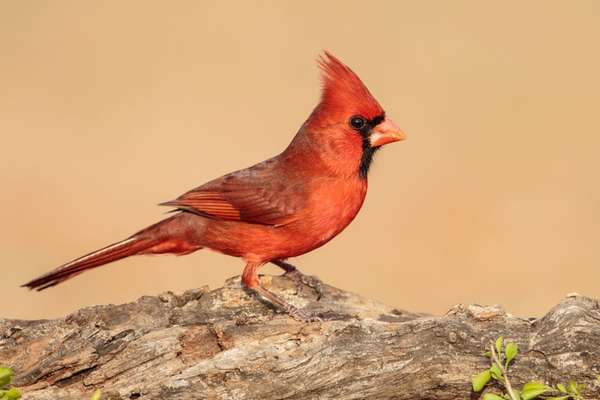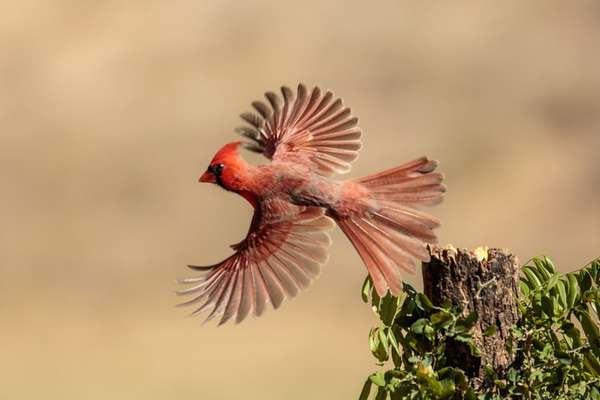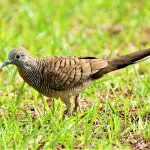Common Name: Northern Cardinal
Scientific Name: Cardinalis cardinalis| Size | Diet | Range in Hawaii | Status in Hawaii |
|---|---|---|---|
| 9 in. | seeds of grasses and corn, fruit, buds, sunflower seeds, and insects | Hawaii (Big Island) | least concern |
The Northern Cardinal is one of the most well-known birds in North America due to its bright red coloration, which attracts both humans and other animals. It is also one of North America’s most well-known songbirds, having been introduced to several states, including Hawaii.
These birds have thrived in their new environment. They’re now common throughout Hawaii, particularly in residential areas where they feed from people’s yards. We’ll give you some details about this species in Hawaii to help you learn more about them!
Northern cardinal

Scientific Name: Cardinalis cardinalis
Appearance
Northern cardinals are medium-sized songbirds with robust, stocky bodies that can weigh between 33.6 and 65 grams. It has a large head, a long tail, and wings with bright red feathers. Their wingspan is 9.8-12.2 inches, and their size ranges from 8.3-9.3 inches.
Females of this species are also significantly smaller than males. The male is more colorful than the female, but both have long, pointed bills and a black mask across their eyes that extends all the way down to their beaks. Males have much more prominent masks than females.
Females are brownish with a hint of red on the wings, tails, and crest. The chicks have the same color feathers as the adult female, but the color changes as they molt.
Diet
The Northern cardinal is an omnivorous bird that feeds on a variety of foods such as seeds, fruits, and insects. This species is a seed eater, primarily consuming seeds from various trees and shrubs.
It also consumes berries, nuts, and fruits when they’re available. Before eating the seeds or shells, it breaks them up with its beak.
They’re also known to eat insects as well as spiders and other arthropods when they’re available. Insects are a source of protein in this bird’s diet.
If available, the Northern cardinal will also consume other small animals like worms or snails. Their diet varies depending on what is available in their habitat at various times of the year.
Behavioral traits
Northern cardinals are a type of songbird that is extremely territorial, singing loud songs to keep other cardinals away from their territory. This alerts the female and nestlings to the presence of a threat in their territory. They also sing to attract mates and communicate with the rest of their flock.
This species is also non-migratory, only fluffing their down feathers to keep warm during the winter. After the winter, you’ll usually hear the cardinal’s song, which sounds like ‘cheer, cheer, cheer.’
Breeding
Cardinals are monogamous birds that mate with one partner during the whole breeding season, but may select a different mate each season. During courtship, males will feed seeds to females in a method called beak-to-beak.
The female lays three to five eggs in a well-hidden nest designed and built from twigs, barks, leaves, rootlets, grasses, and lined with feathers. They build their nests 3-10 feet above the ground.
Before hatching, the eggs are incubated for 11 to 13 days. The female will usually stay in the nest during this time while the male goes out hunting for food for her and their young.
Both parents will feed their offspring insects and spiders after they hatch until these chicks are old enough to go hunting on their own. They’ll leave their nest after 9-11 days and join juvenile flocks until they reach sexual maturity at one year of age.
Habitat
Northern cardinals prefer shrubbery or woodland areas near open fields. This is where their main food source and shelter is located, allowing them to hide immediately from predators, such as hawks or owls, who might swoop down from above while they’re feeding on seeds or berries on the ground below them.
They’ll also live near houses and gardens with bird feeders.
Native

The Northern cardinal is a bird native to North America, and it can be found in Canada and United States. They can be found from southern Canada all the way through parts of Mexico, including Texas, New Mexico, Arizona, and California. Although they aren’t migratory, they do move around depending on the season and food supply.
Hawaii
The Northern Cardinal has been sighted in Hawaii since 1929. It is native to North America but has spread to many other parts of the world. It is commonly seen in urban areas and on the forest floor in Hawaii and is one of the birds that can be heard at dawn.
In Honolulu, only a pair was initially introduced, but it quickly flourished and produced offspring. There are now over 300 cardinals on Kauai, Oahu, and Hawaii.
Conservation Status
The International Union for Conservation of Nature (IUCN) has classified northern cardinals as “least concern” due to their large population numbers across North America; however, some subspecies are considered endangered in their local regions due to deforestation or other human interference with their habitats.
Interesting facts
1. This species undergoes molting
Northern cardinals shed their feathers twice a year, once in late summer and once in early fall. Molting is the process by which old feathers are shed and replaced with new ones. Once the molting process is complete, the color of the bird changes because its new feathers are now different from the old ones.
2. This cardinal is known for attacking its own reflection
Northern cardinals are territorial birds that are known to be aggressive. It’ll even dive toward the mirror and attack its own reflection. This bird can’t recognize himself in the mirror and believes he is being attacked by another cardinal.
3. Seven states have Northern Cardinal as their state bird
The northern cardinal is the state bird of seven states in the United States, including Illinois, Indiana, Kentucky, North Carolina, Ohio, Virginia, and West Virginia.
4. They get their colors from their diet
The pigments in their diet are what give northern cardinals their red color. The birds consume a lot of fruits and berries, which are high in carotenoids and other pigment-containing compounds.
5. They have a very short lifespan in the wild
The Northern cardinal is a lovely bird, but it lives only a few years. A northern cardinal’s average lifespan in the wild is only three years. In captivity, however, they can live for up to 28 years.
Frequently asked questions:
-
What types of cardinals are in Hawaii?
The three cardinal bird species introduced to Hawaii are the red-crested cardinal, northern cardinal, and yellow-billed cardinal. They were brought in by people and spread throughout the islands right away. But now, they’re regarded as invasive species in Hawaii.
-
Are cardinals friendly to humans?
Despite their territorial nature, this species is known to be friendly toward humans. They’re known to recognize human voices and frequently visit bird-friendly gardens with bird feeders.




